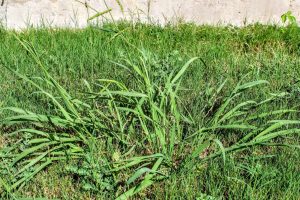Crabgrass is an invasive and unsightly weed that commonly plagues lawns. It stands out like a sore thumb, disrupting the lush green carpet of your yard. To effectively combat this nuisance, it is crucial to understand the characteristics and life cycle of crabgrass. In this article, we will delve into the definition of crabgrass, its impact on lawns, and the reasons why it should be addressed promptly.
Understanding Crabgrass
Crabgrass, as the name suggests, is a type of grass. However, it differs from the desirable turf grasses used in lawns. The primary distinction lies in its life cycle. Crabgrass is classified as an “annual grass,” while lawn grasses are typically “perennial.”
Annual Grass
Annual plants, including crabgrass, complete their life cycle within a single year. These plants sprout from seeds in the spring, grow throughout the summer, and eventually wither and die in the fall. Unlike perennial grasses that live for many years, crabgrass does not produce flowers or fruit. Instead, it focuses on producing an enormous amount of seeds, ensuring its proliferation in the following year.
Perennial Grass
In contrast, perennial grasses persist year after year, providing long-term coverage for lawns. These grasses may even have historical roots, dating back several decades. Although they may turn brown and enter a dormant state during winter or periods of extreme heat and drought, they possess the ability to rebound and thrive when conditions improve.
Why Crabgrass is Detrimental to Lawns
Crabgrass is not suitable for lawns due to its annual life cycle and aggressive growth habits. If your lawn were entirely composed of crabgrass, it would result in unsightly patches of bare soil. When crabgrass dies off in the fall, it leaves behind remnants of roots and stems, creating a messy appearance. In the subsequent spring, new crabgrass plants will sprout, but it will take a significant portion of the growing season for them to cover the lawn adequately. Additionally, crabgrass is a weak plant, easily outcompeted by other weeds.
Seed Production and Persistence
One of the main concerns with crabgrass is its prolific seed production. A single plant can produce an astounding number of seeds, with each seed capable of remaining viable for up to three years. Any areas of your lawn that are bare, have weak grass coverage, or are experiencing stress from factors like heat or turf-damaging insects, become susceptible to crabgrass invasion. Even scalping the lawn by mowing it too short can create an opportunity for crabgrass to take hold.
Managing Crabgrass in Your Lawn
Now that we have a better understanding of crabgrass and its detrimental effects on lawns, let’s explore effective strategies for managing and controlling this persistent weed. A combination of mechanical and chemical methods can help minimize the impact of crabgrass and restore the health and beauty of your lawn.
Mechanical Management
Hand pulling crabgrass and using appropriate weeding tools can be an effective approach, particularly during the early stages of infestation when the weed is young. It is advisable to perform this task when the soil is moist, as it facilitates easier removal of the weed’s roots. Care should be taken to avoid disturbing the soil as much as possible during the process.
Chemical Prevention and Management
The application of selective, preemergent herbicides is a widely practiced method for preventing and managing crabgrass in lawns. These herbicides come in granular form and should be applied using a spreader. It is important to choose a preemergent herbicide that does not contain nitrogen fertilizer.
Several active ingredients are effective against crabgrass, including bensulide, dithiopyr (which also offers postemergent control on young crabgrass seedlings), pendimethalin, and prodiamine. These herbicides form a barrier in the upper layer of the soil, killing weed seedlings upon germination. They have a residual activity that lasts for several weeks, but high temperatures and significant rainfall can reduce their effectiveness.
Tips for Herbicide Application
To achieve optimal results when applying preemergent herbicides:
-
- Apply the herbicide before seed germination, which typically occurs when soil temperatures are sustained at 53-55°F for at least five days. Timing the application with the blooming of forsythia can provide a rough guide, although it may not always be consistently reliable.
- Water the lawn after herbicide application, following the instructions provided on the product label.
- Consider a second application of the herbicide after 6-8 weeks, as indicated on the label.
- Consult the herbicide label for specific recommendations regarding the waiting period between application and overseeding.
For actively growing crabgrass that has already matured and begun producing seeds, spot treatment with postemergent herbicides is recommended. Look for herbicides containing active ingredients such as quinclorac and fenoxaprop-p-ethyl, which effectively target mature crabgrass plants.
Crabgrass is a persistent and unsightly weed that can infiltrate and dominate lawns if left unchecked. Understanding its life cycle, growth habits, and effective management strategies is key to maintaining a healthy and weed-free lawn. By implementing a combination of mechanical methods and judicious use of herbicides, homeowners can successfully combat crabgrass and restore the beauty of their lawns. Remember to follow product labels and guidelines for safe and effective application.
Contact us (859-314-LAWN) for more information or a free instant quote!
—
 About Green & Grow
About Green & Grow
Green & Grow is a full service lawn care company specializing in lawn mowing, fertilization & weed control, aeration & seeding, insect control, and more!
> Learn More




 About Green & Grow
About Green & Grow